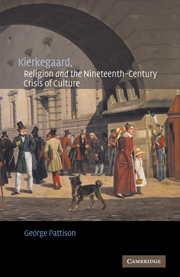Book contents
- Frontmatter
- Contents
- Preface
- Acknowledgements
- List of abbreviations
- 1 The sublime, the city and the present age
- 2 Kierkegaard and the world of the feuilletons
- 3 The present age: the age of the city
- 4 ‘Cosmopolitan faces’
- 5 Food for thought
- 6 A literary scandal
- 7 The reception of Either/Or
- 8 New Year's Day
- 9 Kierkegaard and the nineteenth century (1) Manet
- 10 Kierkegaard and the nineteenth century (2) Dostoevsky
- 11 Learning to read the signs of the times
- Bibliography
- Index
11 - Learning to read the signs of the times
Published online by Cambridge University Press: 22 September 2009
- Frontmatter
- Contents
- Preface
- Acknowledgements
- List of abbreviations
- 1 The sublime, the city and the present age
- 2 Kierkegaard and the world of the feuilletons
- 3 The present age: the age of the city
- 4 ‘Cosmopolitan faces’
- 5 Food for thought
- 6 A literary scandal
- 7 The reception of Either/Or
- 8 New Year's Day
- 9 Kierkegaard and the nineteenth century (1) Manet
- 10 Kierkegaard and the nineteenth century (2) Dostoevsky
- 11 Learning to read the signs of the times
- Bibliography
- Index
Summary
We have been exploring some of the aspects of Kierkegaard's authorship that show him in his role of critic of ‘the Age’. These have led us from the feuilleton world of Figaro, through, amongst other stopping-points, Madame Gyllembourg's novel Two Ages, Schlegel's Lucinde and Schleiermacher's Confidential Letters on Friedrich Schlegel's Lucinde, Manet's portrayal of Jesus Insulted by the Soldiers and Dostoevsky's exploration of such urban neurasthenics as the Underground Man. But what is the distinctively Kierkegaardian element in the course we have been following? What is it about Kierkegaard's response to the emergent culture of nineteenth-century modernity that is most his own? After all, many aspects of his analysis of that culture were shared by many others. His polemic against the public is essentially that of Heiberg, whilst his promotion of the model of Christian martyrdom is plainly derived from a broad current within the Christian tradition itself. Not that we should value Kierkegaard only if or solely on the basis of some purported originality: many of the figures of the modern tradition are not of interest because of their originality in any absolute sense, but rather because of the way in which they combine and re-present themes, images and ideas that belong to our common cultural world.
Let us put it like this: we are not going to learn any new facts about the nineteenth century from Kierkegaard, or even any new methodology for interpreting those facts.
- Type
- Chapter
- Information
- Publisher: Cambridge University PressPrint publication year: 2002



